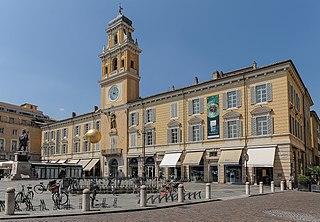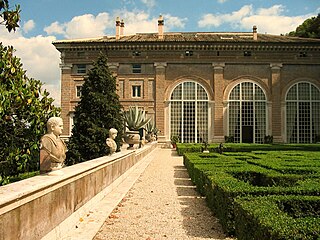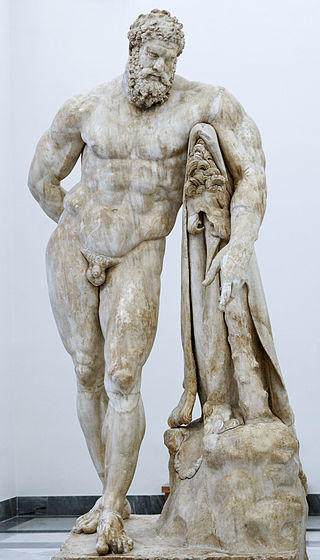


Palazzo Farnese is a palace in Piacenza, northern Italy.



Palazzo Farnese is a palace in Piacenza, northern Italy.

This large partly constructed palace is located on the banks of the River Po in the city of Piacenza in northern Italy. Ottavio Farnese inherited the Duchy of Parma and Piacenza from his father Pier Luigi Farnese, who was assassinated in a coup in 1547. In the aftermath of the assassination Spanish troops under the command of Ferrante Gonzaga occupied both Parma and Piacenza, however, Ottavio didn’t renounce his claim to the duchy and, in 1551, was able to retake Parma with the help of King Henry II of France, nonetheless Piacenza remained in Spanish hands until 1557 when, after the abdications of Charles V, Holy Roman Emperor, both Ottavio and his wife Margaret of Austria traveled to Brussels to meet Philip II of Spain who negotiated an agreement which made the duchy a Spanish fief and returned Piacenza to the Farnese family (though Spanish soldiers were to be stationed in Piacenza's citadel).
The palace was commissioned by Ottavio's wife Margaret, daughter of Emperor Charles V. The new edifice was erected over a former fortress built by the Visconti in 1352, part of which can still be seen.
An initial design was made by Francesco Paciotto, from Urbino, and in 1558, the architect Giacomo Barozzi da Vignola, better known as Vignola, was brought in to revise the designs. Vignola had already been commissioned to design the Villa Farnese at Caprarola (Latium) for Cardinal Alessandro Farnese, the older brother of the duke. Vignola had to take Piacotto's design into account but significantly revised the design which was presented to the patrons in 1561. The drawings are for a vast palace on a scale paralleled only by the Vatican Palace in Italy; the rectangular plan is 113.25 metres by 88 metres and over 40 meters in height. [1] The building works were entrusted to Giovanni Bernardo Della Valle, Giovanni Lavezzari and Bernardo Panizzari (Caramosino). The actual construction, however, made up only less than a half of Vignola's original project and lacked many of the planned architectural features.
The original plan called for a massive rectangular palace with three main floors, three towers, two ceremonial staircases and two spiral ones, each floor was to have two residential complexes (one for Ottavio, another for Margaret) which included an oratory, a chapel, three state rooms, service rooms and a private loggia; and on top of that it included two main loggias on the southern facade, an open theatre on the internal courtyard and Italian gardens that were to reach the main city walls opposite the Po river.
Ultimately the planned building far overestimated the financial capacities of the duchy and of the Farnese family itself, being a far larger palace than those built by other Italian families and even French and Spanish royalty, and even though subsequent Farnese dukes tried to continue the construction, it was finally declared finished in 1602.

After the death of the last Farnese duke Antonio in 1731, the palace fell into disrepair. Restoration began only in the early 20th century and today the Palazzo Farnese at Piacenza houses an important series of museums and exhibitions.
The Ducal Chapel (Cappella Ducale or Cappella Grande) was used by the family for its religious rites. It is a hall on a square plan, turned into an octagon by the introduction of four apses at the corners. The sides have the same length as the chapel's height up to the hemispherical dome. The chapel is decorated with lilies from the Farnese coat of arms and Mannerist masks portraying angels. Other symbols referring to the Ducal family such as the unicorn, starfish, dolphins and turtles, appear in the large frieze.

Parma is a city in the northern Italian region of Emilia-Romagna known for its architecture, music, art, prosciutto (ham), cheese and surrounding countryside. With a population of 198,292 inhabitants, Parma is the second most populous city in Emilia-Romagna after Bologna, the region's capital. The city is home to the University of Parma, one of the oldest universities in the world. Parma is divided into two parts by the stream of the same name. The district on the far side of the river is Oltretorrente. Parma's Etruscan name was adapted by Romans to describe the round shield called Parma.

Ottavio Farnese reigned as Duke of Parma and Piacenza from 1547 until his death and Duke of Castro from 1545 to 1547 and from 1553 until his death.

Piacenza is a city and comune (municipality) in the Emilia-Romagna region of Northern Italy, and the capital of the eponymous province. As of 2022, Piacenza is the ninth largest city in the region by population, with more than 102,000 inhabitants.

The Duchy of Parma and Piacenza was an Italian state created in 1545 and located in northern Italy, in the current region of Emilia-Romagna.

Villa Madama is a Renaissance-style rural palace (villa) located on Via di Villa Madama #250 in Rome, Italy. Located west of the city center and a few miles north of the Vatican, and just south of the Foro Olimpico Stadium. Even though incomplete, this villa with its loggia and segmented columned garden court and its casino with an open center and terraced gardens, was initially planned by Raphael, and highly influential for subsequent architects of the High Renaissance.

GiacomoBarozzida Vignola, often simply called Vignola, was one of the great Italian architects of 16th century Mannerism. His two great masterpieces are the Villa Farnese at Caprarola and the Jesuits' Church of the Gesù in Rome. The three architects who spread the Italian Renaissance style throughout Western Europe are Vignola, Serlio and Palladio. He is often considered the most important architect in Rome in the Mannerist era.

Pier Luigi Farnese was the first Duke of Castro from 1537 to 1545 and the first Duke of Parma and Piacenza from 1545 to 1547. He was the eldest of the three natural sons of Cardinal Alessandro Farnese (1468-1549) and was legitimated in 1505. He was a notable soldier and participated in the Sack of Rome in 1527.

Ranuccio I Farnese reigned as Duke of Parma, Piacenza and Castro from 1592. A firm believer in absolute monarchy, Ranuccio, in 1594, centralised the administration of Parma and Piacenza, thus rescinding the nobles' hitherto vast prerogative. He is best remembered for the "Great Justice" of 1612, which saw the executions of a large number of Piacentine nobles suspected of plotting against him. Claudia Colla his mistress and her mother were accused of using witchcraft to stop him from having offspring, and both were sentenced to death by burning. Because one of the conspirators, Gianfrancesco Sanvitale, falsely implicated several Italian princes, namely Vincenzo Gonzaga, Duke of Mantua and Cesare d'Este, Duke of Modena, in the plot, Vincenzo and Cesare's names appeared on the list of conspirators during formal court proceedings; as a result, Ranuccio's reputation among the rulers of Italy was irreparably damaged because it was evident that he gave credence to Gianfrancesco's obviously false confession. When, consequently, in the early 1620s, Ranuccio was looking for a bride for his younger legitimate son and heir, Odoardo, none of the Italian ruling families were forthcoming with princesses.

The House of Farnese was an influential family in Renaissance Italy. The titles of Duke of Parma and Piacenza and Duke of Castro were held by various members of the family.

Giovanni Lanfranco was an Italian painter of the Baroque period.

Museo di Capodimonte is an art museum located in the Palace of Capodimonte, a grand Bourbon palazzo in Naples, Italy designed by Giovanni Antonio Medrano. The museum is the prime repository of Neapolitan painting and decorative art, with several important works from other Italian schools of painting, and some important ancient Roman sculptures. It is one of the largest museums in Italy. The museum was inaugurated in 1957.

Castell'Arquato is an Italian town located on the first hills of Val D’Arda in the province of Piacenza, in Emilia-Romagna, approximately 30 kilometres (19 mi) from Piacenza and 35 kilometres (22 mi) from Parma. Places nearby include Bacedasco, Vigolo Marchese, Fiorenzuola d'Arda, Lugagnano Val d'Arda, and Vernasca. It is one of I Borghi più belli d'Italia.

Colorno is a comune (municipality) in the Province of Parma in the Italian region Emilia-Romagna, located about 90 kilometres (56 mi) northwest of Bologna and about 15 kilometres (9 mi) north of Parma.

The Palazzo della Pilotta is a complex of edifices located between Piazzale della Pace and the Lungoparma in the historical centre of Parma, region of Emilia Romagna, Italy. Its name derives from the game of pelota played at one time by Spanish soldiers stationed in Parma.

The House of Bourbon-Parma is a cadet branch of the Spanish royal family, whose members once ruled as King of Etruria and as Duke of Parma and Piacenza, Guastalla, and Lucca. The House descended from the French Capetian dynasty in male line. Its name of Bourbon-Parma comes from the main name (Bourbon) and the other (Parma) from the title of Duke of Parma. The title was held by the Spanish Bourbons, as the founder Philip, Duke of Parma was the great-grandson of Ranuccio II Farnese, Duke of Parma. The House of Bourbon-Parma is today the Sovereign House of the Grand Duchy of Luxembourg (agnatically) and all members of the Grand Ducal Family of Luxembourg are members of the House of Bourbon-Parma with the title of "Princes/Princesses" and the predicate of Royal Highness.

The classical sculptures in the Farnese Collection, one aspect of this large art collection, are one of the first collections of artistic items from Greco-Roman antiquity. It includes some of the most influential classical works, including the sculptures that were part of the Farnese Marbles, their collection of statuary, which includes world-famous works like the Farnese Hercules, Farnese Cup, Farnese Bull and the Farnese Atlas. These statues are now displayed in the Naples National Archaeological Museum in Italy with some in the British Museum in London.

Margherita Aldobrandini, was an Italian noblewoman member of the Aldobrandini family and by marriage Duchess consort of Parma and Piacenza during 1600–1622. She was also Regent of both Duchies during 1626–1628 on behalf of her minor son.

The Gazzola Institute is a school of the arts and art museum, located on via Gazzola n°9 in the town of Piacenza, region of Emilia Romagna, Italy.

The Palazzo del Giardino or Palazzo Ducale del Giardino is a historic palace in the Parco Ducale in Parma. It is not to be confused with the official Parma residence of Marie Louise, Duchess of Parma between Palazzo della Pilotta and Palazzo della Provincia in what is now known as piazzale della Pace - she also lived at the Ducal Palace of Colorno and in the Casino dei Boschi in Sala Baganza. The main Ducal Palace in Parma, the Palazzo della Pilotta and the Reinach Theater were all destroyed in an early morning air raid on 13 May 1944, carried out by the 465th Heavy Bombardment Group of the US Airforce, 781st Squadron, which dropped 9 GP bombs on the city centre.

Simone Moschino was an Italian Renaissance sculptor and architect, born in Orvieto as Simone Simoncelli.